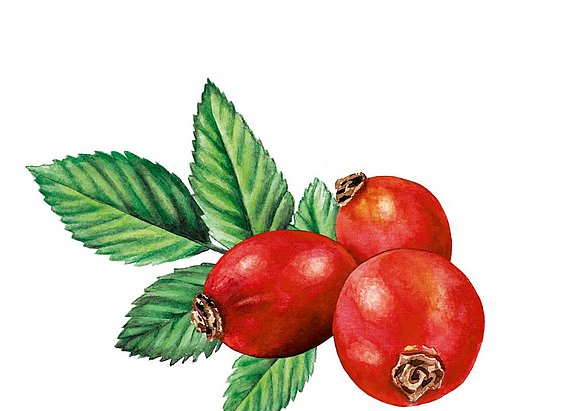The rose hip
Nature's glowing gift
The fruit of the wild rose or dog rose (Rosa canina) is very special indeed. The wild rose is widespread in many parts of the world, from Europe to Africa, from America to Asia. The flowers, which are usually pink, are relatively inconspicuous. However, the fruits, which usually refer to flesh of the rosehip, are full of vital substances for the body.
In autumn, when the rose hips glow en masse, like little light bulbs, covering the leafless shrubs, they begin to emit the first signal of their power. Carotenoids (including lycopene) give the rose hips their intense red to orange colour, which the human body is able to partially convert into Vitamin A. It is a well-known fact that the high Vitamin C content of rose hips far exceeds that of lemons. And, what’s more, they also contain a lot of other micronutrients or secondary plant substances (SPS), which also have excellent properties. These include several B Vitamins, minerals, fibre, fruit acids, tannins, polyphenols, flavonoids, triterpenes, and also galactolipids, which are particularly interesting, due to their proven anti-inflammatory properties.
Galactolipids fall into a category of substances that are made up of molecules of the simple sugar galactose, glycerol and a fatty acid component. One member of the group of galactolipids, which has an unspeakably long name that experts simply abbreviate as “GOPO”, is of particular interest to researchers in the health sector, since it acts as a natural pain reliever.
It usually sparks an interest in people with complaints arising from joint wear and/or inflammatory processes within the joints. Could "GOPO" offer an option for limiting pain with a natural remedy after all? The fact that the rose hip contains an unusually high proportion of natural Vitamin C, in addition to the GOPO galactolipid, is also a noteworthy aspect for joint problems. The immune system also benefits, among other things, from its antioxidant function, and the Vitamin C plays a key role in collagen formation in the connective tissue – which, by the way, does more than merely giving the skin its smooth, firm appearance. It also forms the supporting tissue for cartilage, bones, tendons and muscles, and nourishes the entire musculoskeletal system.
Pay attention to bioavailability
Galactolipids are fat-soluble substances, therefore, unfortunately, a cup of rose hip tea every day, or some rose hip jam with your breakfast, will have no noteworthy effect. GOPO is not water-soluble, and temperatures above 40°C destroy its bioactivity.
Gentle drying and grinding of the fruit flesh into a powder is the best and most common way of preserving the valuable ingredients found in rose hips. It is important to adhere to certain quality criteria, so that the powder retains the bioactive power of the rose hip:
- During the drying process and the further processing steps, a temperature of 40°C may not be exceeded.
- The rose hip should come from certified organic cultivation (or it should at least be traceably inspected for impurities).
- The valuable ingredients found in the rose hip should not be stretched or diluted by additives.
Rose hip powder can be used in a variety of ways. The powder has a pleasant, slightly sour flavour. You can therefore combine it well with drinks and meals such as fruit juice, yoghurt, muesli or salad.
